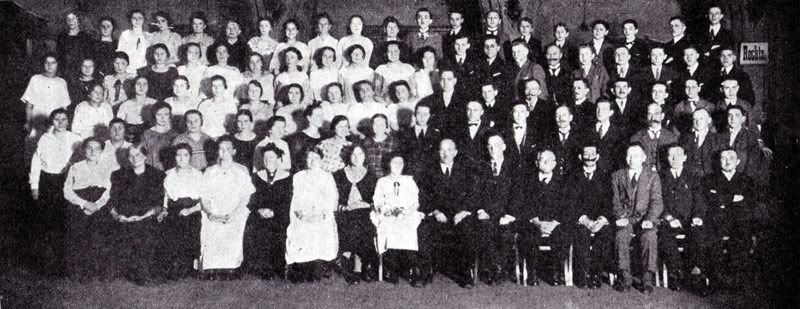Some recent discussion of the Church in pre-World War II Germany suggests that posts about events in that time and place would be of interest … so of course in my skewed way of thinking, the first post concerns a city that isn’t even in Germany anymore.
The city of Wrocław (“Breslau” in German), now in Poland, is part of that historically disputed area that has at times belonged to Germany, Prussia, Poland, Austria, and Bohemia. In the period between the two world wars, it was part of Germany, and assigned to the Swiss-German Mission of the LDS Church. Its population at the time was slightly above a half-million people. And it had been a fruitful field for LDS missionary work – as early as 1910 we had a Breslau branch with 170 members, although in the same year the elders were banished from the country by German officials.
The missionaries soon returned, and by 1922 were baptizing an average of ten people every month in and near Breslau. Although they faced some serious opposition from a few officials, including one pastor who had lived briefly in Utah, the clean lives of the elders and local members successfully refuted much of the slander. According to one elder, “It is quite a revelation to the Germans to see a group of young fellows who do not drink nor smoke in a land where such things are as much a matter of course as things to eat and wear … One of the [Breslau] branch presidents was a German brother who had reared a fine family, [and] is noted for his friendliness, helpfulness and honesty. When the missionaries went tracting and met people who know him they had no trouble in getting them to respond to an invitation to meeting, because they wanted to make the acquaintance of a system which produces such men.”
Civil conditions following the war were difficult: “The German nation is just now in a very important transition point in its history. During the long, miserable months of the rapid depreciation of money, the only thing which held the nation together was a well-trained, efficient police force of picked men, ready to use their rifles on the crowds on the slightest provocation. There have been riots everywhere, and the government is now making a supreme effort to regulate the currency by introducing a new medium of exchange backed by a reasonably good security. It is apparently succeeding.”
On 16-17 December 1923, the three branches that were then part of the Breslau Conference (equivalent to a stake in the mission parlance of the time) gathered at the stock exchange building in Breslau for a major conference. Representative of the changing attitude toward the Mormons is the fact that newly appointed mission president Fred Tadje was hosted by a German police officer, a friend of the Church, during the days of the conference.
Five hundred Saints and 200 of their friends watched a model demonstration of Sunday School recitations and a chorus composed of 65 Sunday School children, with talks on repentance and the Word of Wisdom. Adult meetings followed in the afternoon. Pres. Tadje spoke at all meetings on the topics of priesthood power and missionary work, an elder who was a skilled violinist played several numbers, and the Breslau district choir sang. The vocal solo of one missionary (Norwood Crawford, singing “Forgotten”) drew applause from the audience.
 The highlight of the conference was an evening performance of the oratorio “The Vision” performed by the 90-voice choir of the three Breslau branches. This oratorio, written by Evan Stephens and commissioned by Pres. Heber J. Grant to observe the centennial of the First Vision, was an elaborate effort – Elder John D. Montague had translated the words, the choir rehearsed for three months in preparation for their performance. Fully half of the 1,100 in attendance were not members of the Church, and listened with interest to Pres. Tadje’s talk concerning the First Vision and the 45-minute oratorio.
The highlight of the conference was an evening performance of the oratorio “The Vision” performed by the 90-voice choir of the three Breslau branches. This oratorio, written by Evan Stephens and commissioned by Pres. Heber J. Grant to observe the centennial of the First Vision, was an elaborate effort – Elder John D. Montague had translated the words, the choir rehearsed for three months in preparation for their performance. Fully half of the 1,100 in attendance were not members of the Church, and listened with interest to Pres. Tadje’s talk concerning the First Vision and the 45-minute oratorio.
The next day at sunset, twenty-three converts went with the elders to the banks of the Oder river for baptism. Publicity about the LDS conference had been so extensive that an estimated 1,000 Breslau citizens, not members of the Church, watched curiously and respectfully. Attracted by the crowd, two airplane pilots practicing maneuvers circled the baptismal site, the roar of their motors interfering somewhat with the service. Immediately after the baptisms, one of the elders found a place to stand a few feet above the ground and addressed the crowd to explain what they had just witnessed.
The public nature of the meetings, the public relations value of the choir performance, and the number of people – both Saints and strangers – in attendance all indicate the growth, stability, and acceptance of the Church in that corner of Europe in the years between the wars.
Continue reading at the original source →



